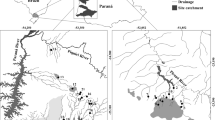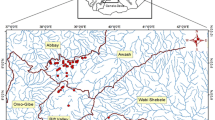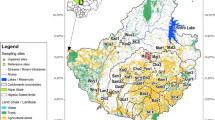Abstract
In accordance with the aims of the E.U. funded AQEM Project, an assessment system module based on aquatic macroinvertebrates was developed for small sized rivers in the southern Apennines (south Italy). Eleven stream sites, impacted to a greater or a lesser extent by organic pollution and/or habitat impairment and chosen to cover the whole degradation gradient present in the geographical area were sampled in three seasons. The samples were collected following a proportional, multihabitat procedure, afterwards considering separately the replicates collected in the depositional (pool) and transport (riffle) areas for the analysis. A PCA multivariate analysis was performed to extract the main axes of variation of the biological community, which resulted in the first axis being strongly correlated to ecological quality. The final assessment module is based on a multimetric system, structured by selecting the best metrics in simulating the first axis gradient. The system considers a total of 15 different metrics, mainly providing information concerning tolerance to pollution, taxa richness, habitat features and trophic structure of the community. In accordance with the WFD requirements, some of these metrics are based on abundance classes of taxa. Depositional and transport units, due to the observed dissimilarity in the structure of their benthic communities, were kept separate during the development of the assessment system to retain this potentially useful information and to clear interpretation of the results. Both `riffle' and `pool' invertebrate data showed clear differences in ecological quality between sites. Nevertheless, the final assessment module is based on the macroinvertebrates inhabiting depositional areas of rivers only, because the metrics for these river units showed a better performance than those examined for the transport river units. The application of the assessment module requires 10 replicates to be quantitatively collected, for a total area of 0.5 m2. In terms of sampling and identification effort, the assessment module shows a good comparability with the standard Italian method presently in use and might thus be easily applied for river sites classification according to the Water Framework Directive in southern Italy. The site classification obtained with the proposed multimetric index shows a very good correspondence with the post-classification based on multivariate analysis.
Similar content being viewed by others
References
Armitage, P. D., D. Moss, J. F. Wright & M. T. Furse, 1983. The performance of a new biological water quality scores system based on macroinvertebrates over a wide range of unpolluted running-water sites. Wat. Res. 17: 333–347.
Balestrini, R., M. Cazzola & A. Buffagni, 2003. Characterizing hydromorphological features of selected Italian rivers: a comparative application of environmental indices. Hydrobiologia, 516: 367–381.
Barbour, M. T., J. Gerritsen, 3G. E. Griffith, R. Frydenborg, E. McCarron, J. S. White & M. L. Bastian, 1996. A framework for biological criteria for Florida streams using benthic macroinvertebrates. J. N. Am. Benthol. Soc. 15 (2): 185–211.
Barbour, M. T., J. Gerritsen, B. D. Snyder, & J. B. Stribling, 1999. Rapid Bioassessment Protocols for Use in Streams and Wadeable Rivers: Periphyton, Benthic Macroinvertebrates and Fish, Second Edition. EPA 841-B-99-002. U.S. Environmental Protection Agency, Office of Water, Washington D.C.
Bargos, T., J. M. Mesanza, A. Basaguren & E. Orive, 1990. Assessing river quality by means of multi factorial methods using macroinvertebrates. A comparative study of main water courses of Biscay. Wat. Res. 24: 1–10.
Belfiore, C., 1983. Guide per il riconoscimento delle specie animali delle acque interne italiane. 24. Efemerotteri (Ephemeroptera). CNR. Ruffo Ed., Verona: 113 pp.
Brabec K., S. Zahrádková, D. Němejcová, P. Pařil, J. Kokeš, J. Jarkovský, 2004. Assessment of organic pollution effect considering differences between lotic and lentic stream habitats. Hydrobiologia 516: 331–346.
Brown, A. V. & P. P. Brussok, 1991. Comparison of benthic invertebrates between riffles and pools. Hydrobiologia 220: 99–108.
Buffagni, A., 1997. Mayfly community composition and the biological quality of streams. In Landolt, P. & M. Sartori (eds), Ephemeroptera & Plecoptera: Biology-Ecology-Systematics, MTL, Fribourg: 235–246.
Buffagni, A. 1999. Pregio naturalistico, qualità ecologica e integrità della comunità degli Efemerotteri (Insecta Ephemeroptera): un indice per la classificazione dei fiumi italiani. Acqua & Aria, 8: 99–107.
Buffagni, A., R. Alber, E. Bielli, S. Erba, J. L. Kemp, M. Cazzola, V. Albrigo, A. Mutschlechner & R. Pagnotta, 2002. Il Progetto AQEM in Italia: aree studiate, metodologia di campionamento e potenziali interazioni con altri settori di indagine. Studi Trentini di Scienze Naturali. Acta Biol. 78 (1): 181–193.
Buffagni, A., G. Crosa, D. M. Harper & J. L. Kemp, 2000. Using macroinvertebrate species assemblages to identify river channel habitat units: an application of the functional habitats concept to a large, unpolluted Italian river (River Ticino, Northern Italy). Hydrobiologia 435: 213–225.
Buffagni, A., J. L. Kemp, S. Erba, C. Belfiore, D. Hering & O. Moog, 2001. A Europe wide system for assessing the quality of rivers using macroinvertebrates: the AQEM project and its importance for southern Europe (with special emphasis in Italy). J. Limnol. 60 (suppl. 1): 39–48.
Buffagni, A. & J. L. Kemp, 2002. Looking beyond the shores of the United Kingdom: addenda for the application of River Habitat Survey in South European rivers. J. Limnol. 61 (2): 199–214.
D. L. 152/99-Decreto Legislativo 11 maggio 1999, n. 152-Disposizioni sulla tutela delle acque dall'inquinamento e recepimento della direttiva 91/271/CEE concernente il trattamento delle acque reflue urbane e della direttiva 91/676/CEE relativa alla protezione delle acque dall'inquinamento provocato dai nitrati provenienti da fonti agricole. Suppl. Ord. n. 101/L alla Gazzetta Ufficiale 29 maggio 1999, no. 124.
Doisy, K. E. & C. F. Rabeni, 2001. Flow conditions, benthic food resources, and invertebrate community composition in a lowgradient stream in Missouri. J. N. Am. Benthol. Soc. 20 (1): 17–32.
E.U., 2000. Directive 2000/60/EC of the European Parliament and of the Council of 23 October 2000 establishing a framework for Community action in the field of water policy. Official Journal of the European Communities L 327, 22.12.2000, 1–72.
Ghetti, P. F., 1986. I macroinvertebrati nell'analisi di qualità dei corsi d'acqua. Provincia Autonoma di Trento, Trento: 105 pp.
Ghetti, P. F., 1995. Indice Biotico Esteso (I.B.E.). Notiziario dei Metodi Analitici. IRSA-CNR, 7 luglio 1995, Roma: 1–24.
Ghetti, P. F., 1997. Indice Biotico Esteso (I.B.E.). I macroinvertebrati nel controllo della qualità degli ambienti di acque correnti. Provincia Autonoma di Trento: 222 pp.
Ghetti, P. F. & G. Bonazzi, 1981. I macroinvertebrati nella sorveglianza ecologica dei corsi d'acqua. Collana del Progetto Finalizzato: Promozione della Qualità dell'Ambiente, CNR AQ/1/127.
Graca, M. A. S. & C. N. Coimbra, 1998. The elaboration of indices to assess biological water quality. A case study.Wat. Res. 32 (2): 380–392.
Helsel, D. R. & R. M. Hirsch, 1992. Statistical Methods in Water Resources. Elsevier, Amsterdam, 522 pp.
Hering, D., A. Buffagni, O. Moog, L. Sandin, M. Sommerhäuser, I. Stubauer, C. Feld, R. K. Johnson, P. Pinto, N. Skoulikidis, P. F. M. Verdonschot & S. Zahrádková, 2003. The development of a system to assess the ecological quality of streams based on macroinvertebrates-design of the sampling programme within the AQEM project. Int. Rev. Hydrobiol. 88: 345–361.
Hering, D., O. Moog, L. Sandin & P. F. M. Verdonschot, 2004. Overview and application of the AQEM assessment system. Hydrobiologia 516: 1–20.
Karr, J. R., K. D. Fausch, P. L. Angermeier, P. R. Yant & I. J. Schlosser, 1986. Assessing biological integrity in running waters: A method and its rationale. Special publication 5. Illinois Natural History Survey.
Kerans, B. L. & J. B. Karr, 1994. A Benthic index of biotic integrity (B-IBI) for rivers of the Tennessee valley. Ecol. Appl. 4 (4): 768–785.
Milner, A. M. & M. W. Oswood, 2000. Urbanization gradients in streams of Anchorage, Alaska: a comparison of multivariate and multimetric approaches to classification. Hydrobiologia 422/423: 209–223.
Morais, M., P. Pinto, P. Guilherme, J. Rosado & I. Antunes, 2004. Assessment of temporary streams: the robustness of metric and multimetric indices under different hydrological conditions. Hydrobiologia 516: 229–249.
Nijboer, R. C., R. K. Johnson, P. F. M. Verdonschot, M. Sommerhäuser & A. Buffagni, 2004. Establishing reference conditions for European streams. Hydrobiologia 516: 91–105.
Ofenböck, T., O.Moog, J. Gerritsen & M. Barbour, 2004. A stressor specific multimetric approach for monitoring running waters in Austria using benthic macro-invertebrates. Hydrobiologia 516: 251–268.
Parsons, M. & R. H. Norris, 1996. The effect of habitat specific sampling on biological assessment of water quality using a predictive model. Freshwat. Biol. 36: 419–434.
Peeters, E. T. H. M., J. J. P. Gardeniers & H. H. Tolkamp, 1994. New methods to assess the ecological status of surface waters in The Netherlands Part 1: Running waters. Verh. int. Verein. Limnol. 25: 1914–1916.
Pinto, P., J. Rosado, M. Morais & I. Antunes, 2004. Assessment methodology for southern siliceous basins in Portugal. Hydrobiologia 516: 191–214.
Plafkin, J. L., M. T. Barbour, K. D. Porter, S. K. Gross & R. M. Hughes, 1989. Rapid Bioassessment Protocols For Use in Streams And Rivers. Benthic Macroinvertebrates And Fish. U. S. Environmental Protection Agency. Assessment and Watershed protection Division. EPA/444/4-89-001. Washington D.C.
Raven, P. J., T. H. Holmes, F. H. Dawson, P. J. A. Fox, M. Everard, I. R. Fozzard & K. J. Rouen, 1998 a. River Habitat Survey, the physical character of rivers and streams in the UK and Isle of man. River Habitat Survey No. 2, May 1998. The Environment Agency, Bristol, 86 pp.
Raven, P. J., T. H. Holmes, F. H. Dawson, P. J. A. Fox, M. Everard, I. R. Fozzard & K. J. Rouen, 1998 b. River Habitat Quality: the physical characteristics of rivers and streams in the UK and Isle of Man. Report No. 2. Environment Agency, U.K.
Resh, V. H., R. H. Norris & M. T. Barbour, 1995. Design and implementation of rapid bioassessment approaches for water resource monitoring using benthic macroinvertebrates. Aust. J. Ecol. 20: 108–121.
Reynoldson, T. B., K. E. Day & T. Pascoe, 2000. The development of BEAST: a predictive approach for assessing sediment quality in the North American Great Lakes. In Wright, J. F., D. W. Sutcliffe & M. T. Furse (eds), Assessing the Biological Quality of Fresh Waters-RIVPACS and Other Tecniques. FBA: 165–180.
Rivosecchi, L., 1984. Ditteri (Diptera). Guide per il riconoscimento delle specie animali delle acque interne italiane. C.N.R., Verona, 28: 177 pp.
Sandin, L., J. Dahl & R. K. Johnson, 2004. Assessing acid stress in Swedish boreal and alpine streams using benthic macroinvertebrates. Hydrobiologia 516: 129–148.
Siligardi, M., S. Bernabei, C. Cappelletti, E. Chierici, F. Ciutti, F. Egaddi, A. Franceschini, B. Maiolini, L. Mancini, M. R. Minciardi, C. Monauni, G. L. Rossi, G. Sansoni, R. Spaggiari & M. Zanetti, 2000. I.F.F. Indice di funzionalità fluviale. Manuale ANPA/2000: 223 pp.
Skoulikidis, N. Th., K. C. Gritzalis, T. Kouvarda & A. Buffagni, 2004. The development of an ecological quality assessment and classification system for Greek running waters based on benthic macroinvertebrates. Hydrobiologia 516: 149–160.
Sladecek, V., 1973. Systems of water quality from the biological point of view. Arch. Hydrobiol. Beiheft 7: 1–217.
Ter Braak, C. J. F. & I. C. Prentice, 1988. A theory of Gradient Analysis. Advances in Ecological Research 18: 271–317.
Ter Braak, C. J. F. & P. F. M. Verdonschot, 1995. Canonical correspondence analysis and related multivariate methods in aquatic ecology. Aquat. Sci. 57 (3): 255–289.
Ter Braak, C. J. F. & P. Smilauer, 1997. CANOCO, Software for Canonical community Ordination (ver. 4.02). Centre for Biometry, Wageningen, The Netherlands.
Ter Braak, C. J. F. & P. Smilauer, 1998. CANOCO Reference Manual and User's Guide to CANOCO for Windows. Centre for Biometry, Wageningen, The Netherlands.
Verdonschot, P. F. M., 2000. Integrated ecological assessment methods as a basis for sustainable catchment management. Hydrobiologia 422/423: 389–412.
Woodiwiss, F. S., 1964. The biological system of stream classification used by the Trent River Board. Chemistry and Industry 14: 443–447.
Wright, J. F., 1995. Development and use of a system for predicting the macroinvertebrate fauna in flowing waters. Aus. J. Ecol. 20: 181–198.
Zahrádková, S., J. Kokeš, J. Hodovský, D. Vojtíšková, D. Scheibová, Y. Poøízková, J. Schenková & J. Helešic, 2000. Predikèní systém PERLA-Prediction system PERLA. In Rulík, M. (ed.), Limnologie na pøelomu tisíciletí. Sborník referátù XII limnologické konference. Olomouc: Univerzita Palackého: 260–264.
Author information
Authors and Affiliations
Rights and permissions
About this article
Cite this article
Buffagni, A., Erba, S., Cazzola, M. et al. The AQEM multimetric system for the southern Italian Apennines: assessing the impact of water quality and habitat degradation on pool macroinvertebrates in Mediterranean rivers. Hydrobiologia 516, 313–329 (2004). https://doi.org/10.1023/B:HYDR.0000025273.15958.6a
Issue Date:
DOI: https://doi.org/10.1023/B:HYDR.0000025273.15958.6a




